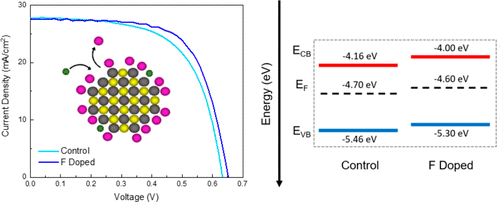当前位置:
X-MOL 学术
›
ACS Mater. Lett.
›
论文详情
Our official English website, www.x-mol.net, welcomes your
feedback! (Note: you will need to create a separate account there.)
Colloidal Quantum Dot Solar Cell Band Alignment using Two-Step Ionic Doping
ACS Materials Letters ( IF 9.6 ) Pub Date : 2020-10-30 , DOI: 10.1021/acsmaterialslett.0c00379 Koen Bertens 1 , James Z. Fan 1 , Margherita Biondi 1 , Armin Sedighian Rasouli 1 , Seungjin Lee 1 , Peicheng Li 2 , Bin Sun 1 , Sjoerd Hoogland 1 , F. Pelayo García de Arquer 1 , Zheng-Hong Lu 2 , Edward H. Sargent 1
ACS Materials Letters ( IF 9.6 ) Pub Date : 2020-10-30 , DOI: 10.1021/acsmaterialslett.0c00379 Koen Bertens 1 , James Z. Fan 1 , Margherita Biondi 1 , Armin Sedighian Rasouli 1 , Seungjin Lee 1 , Peicheng Li 2 , Bin Sun 1 , Sjoerd Hoogland 1 , F. Pelayo García de Arquer 1 , Zheng-Hong Lu 2 , Edward H. Sargent 1
Affiliation

|
Colloidal quantum dot (CQD) solar cells composed of ionic halide passivated active layers benefit from improved passivation and high carrier mobility because of short interparticle distance. However, non-ideal band alignment of the active layer limits the potential open-circuit voltage (VOC) produced by the solar cell. We initiated a suite of simulation-based studies of CQD solar cells and found a route to improved performance by increasing the degree of p-type behavior. Fluoride, while it is a p-type ionic ligand as desired, is incompatible with traditional ligand exchange processes. In prior studies, it has shown to etch the lead sulfide surface uncontrollably. Instead, we develop a multistep halide exchange method, in which the CQD active layer is doped with fluoride ions after ligand exchange. This new method prevents CQD surface etching without impeding charge transport, resulting in a statistically significant improvement in VOC, fill factor, and power conversion efficiency.
中文翻译:

使用两步离子掺杂的胶体量子点太阳能电池能带对准
由离子卤化物钝化的活性层组成的胶体量子点(CQD)太阳能电池由于粒子间距离短而具有改进的钝化和高载流子迁移率的优点。但是,有源层的非理想带取向会限制潜在的开路电压(V OC)由太阳能电池产生。我们发起了一系列基于模拟的CQD太阳能电池研究,并找到了通过提高p型行为程度来提高性能的途径。氟化物是所需的p型离子配体,但与传统的配体交换过程不兼容。在先前的研究中,它已显示无法控制地蚀刻硫化铅表面。取而代之的是,我们开发了一种多步骤卤化物交换方法,其中CQD活性层在配体交换后掺杂了氟离子。这种新方法可在不妨碍电荷传输的情况下防止CQD表面蚀刻,从而在V OC,填充系数和功率转换效率方面具有统计学上的显着提高。
更新日期:2020-12-07
中文翻译:

使用两步离子掺杂的胶体量子点太阳能电池能带对准
由离子卤化物钝化的活性层组成的胶体量子点(CQD)太阳能电池由于粒子间距离短而具有改进的钝化和高载流子迁移率的优点。但是,有源层的非理想带取向会限制潜在的开路电压(V OC)由太阳能电池产生。我们发起了一系列基于模拟的CQD太阳能电池研究,并找到了通过提高p型行为程度来提高性能的途径。氟化物是所需的p型离子配体,但与传统的配体交换过程不兼容。在先前的研究中,它已显示无法控制地蚀刻硫化铅表面。取而代之的是,我们开发了一种多步骤卤化物交换方法,其中CQD活性层在配体交换后掺杂了氟离子。这种新方法可在不妨碍电荷传输的情况下防止CQD表面蚀刻,从而在V OC,填充系数和功率转换效率方面具有统计学上的显着提高。









































 京公网安备 11010802027423号
京公网安备 11010802027423号